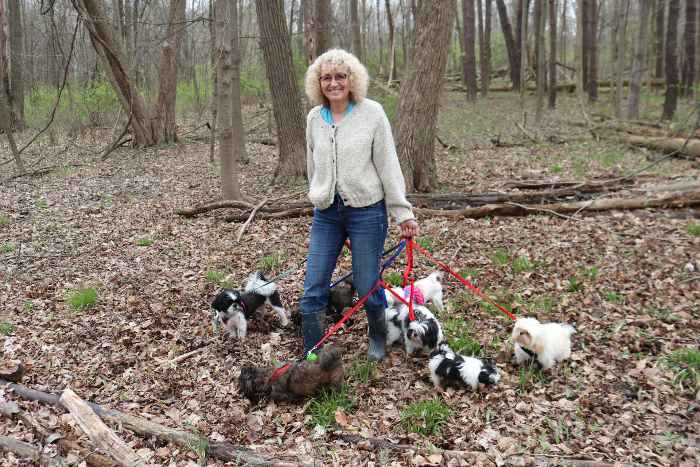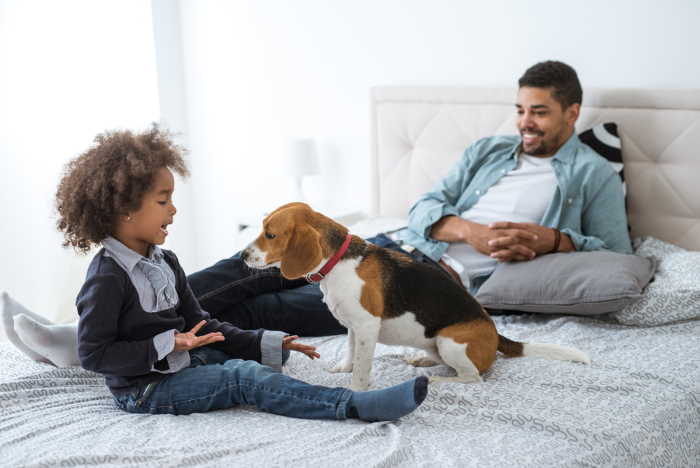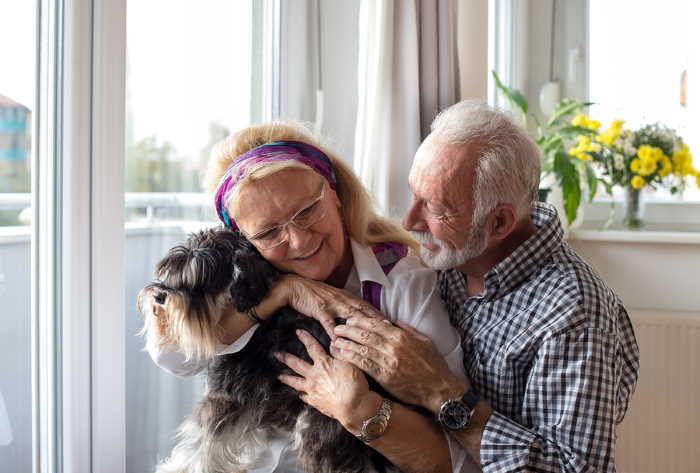- Small Dog Place Home
- Lifestyle
- Bond With Your Dog
How to Build a Stronger Bond with Your Dog
To build a strong bond with your dog, be patient and stay positive. You will become the closest of companions before you know it.
Published 08-02-2021
Since the outbreak of COVID-19, we have all been socially isolated, lives have been dramatically changed, and bad news has flooded from every direction. It is almost impossible not to feel worried right now. A strong connection with your dog can assist in relieving some stress that has come during this difficult time.
According to specialists such as the Human Animal Bond Research Institute, socializing with pets helps to reduce loneliness, anxiety, and depression.
 How to Build a Stronger Bond with Your Dog
How to Build a Stronger Bond with Your DogWhile being locked up at home can be stressful, it is an excellent opportunity to develop a bond with your fluffy companion.
We consulted animal behaviorists, experienced dog trainers, and even veterinarians for the best advice on how to do this properly.
Because dogs are unique, what works for one might not work for another. Before getting a dog, it is recommended to consult a veterinarian and a doctor (if you have allergies).
So, are you wanting to build a stronger bond with your dog? Without further ado, let us find out.
Building Bonds with Dogs
Pay Attention
Pet dogs, like humans, can sense when they have your attention. So rather than scratching its head while watching TV or using your phone, make an additional effort to rub its belly. The gesture will be appreciated and won't go unnoticed.
Spend Quality Time

To achieve quality time, you may join in a lively training session, do some grooming, take a long walk together, or even simply relax and sit with your pet companion. Whatever activity you pick, make sure it lasts at least 30 minutes.
Communication is Key
The first step in developing an excellent relationship with your dog is developing a reliable method of communication. In other words, you must stick to your training guidelines consistently. When you and your dog have a greater understanding of one another, your relationship will be much stronger.
Use Visual Communication
Visual communications should be used more often than verbal communications. Keep in mind that every opportunity to train him should be embraced since your dog always watches your every action.
Dogs communicate nonverbally through their body language. Learn to read those signals and the bond with your dog will deepen greatly.
Train Every Day
Dogs require mental stimulation, and they find joy in training. Because your dog is always watching and learning from you, whether you are aware of it or not, try to make the most of every opportunity.
There are many dog trick ideas all over the internet. Whether you are teaching your dog a new trick or doing mini-obedience lessons on your daily walks, ensure that some kind of training and mental stimulation is carried out consistently.
Play Games

Your dog shouldn't be trained too much and needs some playtime. Playing games with your dog can engage both the mind and body, as well as strengthen your connection.
Know your Dog's Preferences
Every dog, just like a human, has its own distinct personality. Some dogs want to cuddle with you all day, and others like to be left alone to do their own thing.
For example, one dog might enjoy a thrilling game of fetch, while another would choose to lounge around all day in front of the TV with you.
You should pay close attention to the types of activities your dog enjoys and the types of social environments in which they are comfortable or uncomfortable.
Understanding the ins and outs of their personality will help them to live their best life, and they will know they can put their complete trust in you and your family.
Be Patient
When you are just starting to form a bond with your pup, be patient. Dogs are sensitive to their owners' emotions, so if you lose your cool, your dog will get irritated or fearful. So, instead, keep your cool and deal with every situation calmly so that your dog knows he can always count on you.
Do not have High Expectations
If you ask your dog to do something that seems too tough for him at first, he will get upset and unhappy. T
o prevent your dog from getting discouraged when learning new tricks, break down obedience activities into manageable stages. It will help your dog gain confidence and have fun while learning new tricks.
As a result of developing your dog's self-confidence, there will be greater confidence placed on you as a dependable owner.
Teach How to Ask for Food
Before giving your dog a treat, you should get your dog to do a few tricks as a way of asking for food. If you do this regularly, your dog will start to learn that they must first watch and listen to you before jumping into the food bowl.
Keep your pup's favorite game or toy reserved for playtime, and they will learn to make a bond with you. Once you have developed a routine, you will find that your dog starts to pay attention to you in a substantially different way.
Give Rewards
Is there a particular food, toy, or activity that your dog really adores? Figure out what it is, and whenever you get a chance, take a minute to brighten your pet's day.
For example, when you both finish a tough training session or a lengthy walk, give a reward for your dog's absolute favorite treat.
Cuddle More

Your dog may have a cuddly personality, and there may be nothing they like more than snuggling up close to you in bed. Certain dogs crave physical contact, and brushing and petting them may even be beneficial in lowering their stress levels in certain circumstances. Consequently, if your pet dog cuddles up to you, be sure to return the love.
You should let your dog know that you love him as much as your dog loves you. Give a nightly belly rub, go for a vigorous morning run, or give a lot of puppy kisses. It will definitely make a strong bond between the two of you. Good luck!
About Janice (author and voice behind this site)
Janice Jones has lived with dogs and cats for most of her life and worked as a veterinary technician for over a decade. She has also been a small-breed dog breeder and rescue advocate and holds academic training in psychology, biology, nursing, and mental health counseling. Her work focuses on helping dog owners make informed, responsible decisions rooted in experience, education, and compassion.
When not writing, reading, or researching dog-related topics, she likes to spend time with her six Shih Tzu dogs, her husband, and her family, as well as knitting and crocheting. She is also the voice behind Miracle Shih Tzu and Smart-Knit-Crocheting
Does This Article Deserve Your Thumbs Up?
We always appreciate your support and encouragement. Your thumbs up means so much to us. Please like this article.
If you find this page or any page on Small Dog Place Helpful, or useful in anyway, I'd love it if you would click the small heart found on the bottom right of each page.
You can also share or bookmark this page -- just click on the:

Free Monthly Newsletter
Sign Up for Our Free Newsletter and get our Free Gift to You.
my E-book, The Top 10 Mistakes People Make When Choosing a Dog (and how to avoid them)

